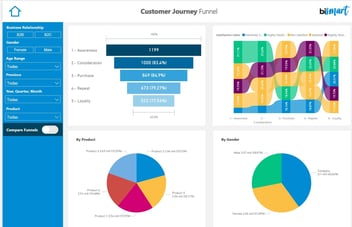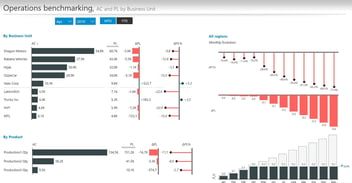The success or failure of a dashboard implementation depends on a number of requirements and factors. Take a look at the 10 factors you should consider.
A dashboard is an essential tool for the proper functioning of a company. However, for a successful implementation, we must take into account several factors and requirements.

Dashboards are connected to a company's overall business strategy, as well as to the specific strategies of the different departments and business units. Balanced scorecards and dashboards allow companies to study their business activity and track the established business objectives through performance indicators. Data analysis plays a strategic role in business and a dashboard is basically the instrument that allows decision-makers to steer the organization.
However, the implementation of a scorecard in an organization should be a process of never-ending improvement. Business strategies are constantly evolving and, therefore, dashboards should be revisited from time to time to make the necessary changes to adapt the tool to the new business objectives and current circumstances.
On the other hand, it is important to keep in mind that the adoption and implementation of a dashboard is not automatic and needs an adaptation period to ensure that its operation, analysis, design and usability are aligned with the needs of the company and that the users of the dashboard know how to work with it.
The implementation of any new technological solution always comes with challenges and asks for a number of requirements for the project to be successful.
10 factors you must consider before a dashboard implementation
1. Data quality
En primer lugar, antes de implementar un cuadro de mando debemos tener en cuenta que un dashboard no es una herramienta mágica. Es decir, el cuadro de mando depende de nuestros datos y de la data quality de los mismos. Para que el cuadro de mando cumpla con los objetivos que se han establecido a su implementación, es fundamental que los datos que ejecuta sean de calidad.
First of all, before implementing a dashboard, we must udnerstand that a dashboard is not a magic tool. Dashboards depend on the quality of our data. For the dashboard to meet the objectives that have been set for its implementation, it is essential that our data is of high quality.
At the end of the day, the quality of our decisions depends on the quality of our data. Thus, the performance of our scorecard also depends on the quality of our data.
2. The definition of performance indicators
Once we have ensured the availability and quality of our data, we must define and establish the performance indicators that will build the storytelling and overall analysis of our dashboard.
The definition of performance indicators and KPIs is undoubtedly one of the most complex and at the same time most decisive steps in our business intelligence strategy. Performance indicators are linked to our company's business objectives and, therefore, their correct definition will determine their correct monitoring of our activity.
3. Number of performance indicators
Más allá del contenido de los indicadores, también es importante tener cuidado con la cantidad de indicadores. Un cuadro de mando con demasiados indicadores puede dificultar la correcta lectura y entendimiento del progreso de nuestra actividad. Por el contrario, un dashboard con pocos indicadores nos ofrecerá una visión sesgada del cumplimiento de nuestros objetivos.
Beyond the content of the indicators, it is also important to be careful with the number of performance indicators we use. A dashboard with too many indicators can be difficult to read and understand. However, a dashboard with too few indicators will give us a biased view of our performance.
Therefore, it is highly important to deeply think about what we want to monitor and to express it through the appropriate number of indicators.
4. Top-down approach
In relation to the previous point, it is essential that our scorecard is built using a top-down approach, which will show us the most important performance indicators in the first line of vision and the more specific indicators in second place.
The top-down approach builds a portrait of the activity starting from the most strategic aspects and enables in-depth exploration so that business users can go deeper and get to the source of the data.
5. Types of dashboards
As we have already mentioned, organizations usually have several dashboards and not all of them serve the same purpose.
There are different types of dashboards and their design and content depends on what they monitor and on their purpose.
Generally speaking, there are 4 types of dashboards:
6. Commited decision-makers
The commitment of the company's management team and decision-makers in the initial and final phases of the dashboard implementation is essential.
A dashboard reflects the business strategy and, therefore, the company's management team must review and validate the establishment of the business objectives, the definition of the performance indicators and the general approach of the dashboard. On the other hand, in the final stages of the project, senior management will be in charge of validating that the dashboard meets the established objectives, that it is well constructed, that it offers the right storytelling and that its design and usability are appropriate.
7. Training
A dashboard is an interactive tool whose performance is tied to user interaction. In other words, end users must be able to interact with the dashboard, as well as to understand the data and the picture it provides.
There are many technologies through which to create and implement dashboards. For our investment to be productive, it is advisable that the implementation of the dashboard comes with specific training for the end users. The training should not only cover technical aspects, but we must also train employees so that they can understand the data, the performance indicators and draw conclusions while using the tool.
8. Dashboard usability
Usability plays a key role in empowering users to work with a tool. The end users of a dashboard are usually business users with little technical knowledge. Therefore, it is essential that our scorecard has the appropriate usability standards according to the level of technical knowledge of the users who are going to use it.
9. Interoperability of corporate platforms
Dashboards are part of a data flow that goes from data collection to data-driven decisions. This flow involves a large number of systems, software and technologies that must be connected to each other so that the flow is not interrupted.
The interoperability of our dashboard with the rest of the corporate platforms and systems is essential.
10. Real-time data and updates
As we have already seen, a dashboard should not be a static entity, since it is linked to the business activity and strategies, which are constantly evolving.
In this sense, it is really important that we opt for a dashboard that contemplates and facilitates data updates, as well as changes on performance indicators and the design of the dashboard when necessary.
Obviously, data must be updated automatically and it is also recommended that our dashboard comes with alerts that warn us everytime an anomaly is detected.
Conclusion
In general terms the correct implementation of a dashboard depends on several factors that must be considered before making an investment.
Beyond what has been mentioned in this article, it is essential that companies do a research on the different technologies that exist for creating and implementing dashboards and that they make sure that the solution they choose has the capabilities needed to meet the established objectives.
At Bismart, a Microsoft Power BI partner, we develop our dashboards with Power BI, the leader of Gartner's Magic Quadrant 2022 and the solution that offers the best capabilities for creating business dashboards.



